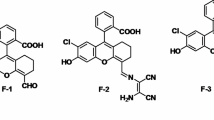Abstract
The cyanate anion (CNO−), formed spontaneously within cells from urea and carbamoyl phosphate, usually functions as a biomarker of some diseases such as chronic kidney disease. Therefore, accurate determination of CNO− is highly demanded. Herein, a 3-amino-2-naphthoic acid-based “turn-on” fluorescence probe was developed for specific detection of CNO−. Upon the addition of sodium cyanate, the weak-fluorescent 3-amino-2-naphthoic acid could react with CNO−, which triggered intense emission of green fluorescence. And up to 9-fold fluorescence enhancement was observed. The fluorescence enhancement ratios displayed a good linear relationship with the concentrations of CNO− in the range of 0.5–200 μM. The high selectivity and sensitivity for CNO− detection were investigated with the detection limit as low as 260 nM. The probe was further successfully applied to determine CNO− in real samples such as tap water, human urine and serum samples, which offered a promising approach in practical applications.

Graphical abstract






Similar content being viewed by others
References
Qian M, Eaton JW, Wolff SP. Cyanate-mediated inhibition of neutrophil myeloperoxidase activity. Biochem J. 1997;326(Pt 1):159–66.
Purcarea C, Ahuja A, Lu T, Kovari L, Guy HI. Aspartate transcarbamoylase, an enzyme specialized for the efficient utilization of unstable carbamoyl phosphate at elevated temperature. J Biol Chem. 2003;278:52924–34.
Palatinszky M, Herbold C, Jehmlich N, Pogoda M, Han P, von Bergen M, et al. Cyanate as an energy source for nitrifiers. Nature. 2015;524:105.
Nilsson L, Lundquist P, Kågedal B, Larsson R. Plasma cyanate concentrations in chronic renal failure. Clin Chem. 1996;42:482–3.
Zvinowanda CM, Okonkwo JO, Gurira RC. Improved derivatisation methods for the determination of free cyanide and cyanate in mine effluent. J Hazard Mater. 2008;158:196–201.
Widner B, Mulholland MR, Mopper K. Chromatographic determination of nanomolar cyanate concentrations in estuarine and sea waters by precolumn fluorescence derivatization. Anal Chem (Wash). 2013;85:6661–6.
Kozliak EI, Fuchs JA, Guilloton MB, Anderson PM. Role of bicarbonate/CO2 in the inhibition of Escherichia coli growth by cyanate. J Bacteriol. 1995;177:3213–9.
Mun KC, Golper TA. Impaired biological activity of erythropoietin by cyanate Carbamylation. Blood Purif. 2000;18:13–7.
Craig AM, Tor-Agbidye J, Blythe LL, Sabri MI, Lasarev MR, Spencer PS, et al. Bioactivation of cyanide to cyanate in sulfur amino acid deficiency: relevance to neurological disease in humans subsisting on cassava. Toxicol Sci. 1999;50:228–35.
Tellez I, Johnson D, Nagel RL, Cerami A. Neurotoxicity of sodium cyanate. Acta Neuropathol (Berl). 1979;47:75–9.
Eiger S, Black SD. Analysis of plasma cyanate as 2-nitro-5-thiocarbamylbenzoic acid by high-performance liquid chromatography. Anal Biochem. 1985;146:321–6.
Lundquist BB-GP, Kagedal B, Nilsson L, Rosling H. Fluorometric determination of cyanate in plasma by conversion to 2,4(1H,3H)-quinazolinedione and separation by high-performance liquid chromatography. Anal Biochem. 1993;211:23–7.
Ohe TH, da Silva AA, Rocha Tda S, de Godoy FS, Franco DW. A fluorescence-based method for cyanate analysis in ethanol/water media: correlation between cyanate presence and ethyl carbamate formation in sugar cane spirit. J Food Sci. 2014;79:C1950–5.
Marier JR, Rose D. Determination of cyanate, and a study of its accumulation in aqueous solutions of urea. Anal Biochem. 1964;7:304–14.
Luque-Almagro VM, Blasco R, Fernández-Romero JM, de Castro MDL. Flow-injection spectrophotometric determination of cyanate in bioremediation processes by use of immobilised inducible cyanase. Anal Bioanal Chem. 2003;377:1071–8.
Zhou J, Booker C, Li R, Zhou X, Sham T-K, Sun X, et al. An electrochemical avenue to blue luminescent nanocrystals from multiwalled carbon nanotubes (MWCNTs). J Am Chem Soc. 2007;129:744–5.
Tian X-C, Huang X, Wang D, Gao F. Eco-efficient one-pot synthesis of quinazoline-2,4(1(H),3(H))-diones at room temperature in water. Chem Pharm Bull. 2014;62:824–9.
Miller JN. Basic statistical methods for analytical chemistry. Part 2. Calibration and regression methods. A review. Analyst. 1991;116:3.
Acknowledgements
We thank Prof. Baoxue Yang (Peking University Health Center) for nice suggestions. This work was supported by the National Natural Science Foundation of China (Grants No. 21672015 and 21708001), National Major Scientific and Technological Special Project for “Significant New Drugs Development” (Grant No. 2017ZX09303013) as well as China Postdoctoral Science Foundation (Grant No. 2018 M631272).
Author information
Authors and Affiliations
Corresponding author
Ethics declarations
Conflict of interest
The authors declare that they have no conflict of interest.
Ethics approval and consent to participate
All human studies were approved by the Peking University Institutional Review Board Office. All human urine samples are supplied by the healthy volunteers with their informed consent.
Additional information
Publisher’s note
Springer Nature remains neutral with regard to jurisdictional claims in published maps and institutional affiliations.
Electronic supplementary material
ESM 1
(PDF 1009 kb)
Rights and permissions
About this article
Cite this article
Feng, J., Zhong, J. & Tang, X. Selective and sensitive detection of cyanate using 3-amino-2-naphthoic acid-based turn-on fluorescence probe. Anal Bioanal Chem 411, 3613–3619 (2019). https://doi.org/10.1007/s00216-019-01843-w
Received:
Revised:
Accepted:
Published:
Issue Date:
DOI: https://doi.org/10.1007/s00216-019-01843-w




